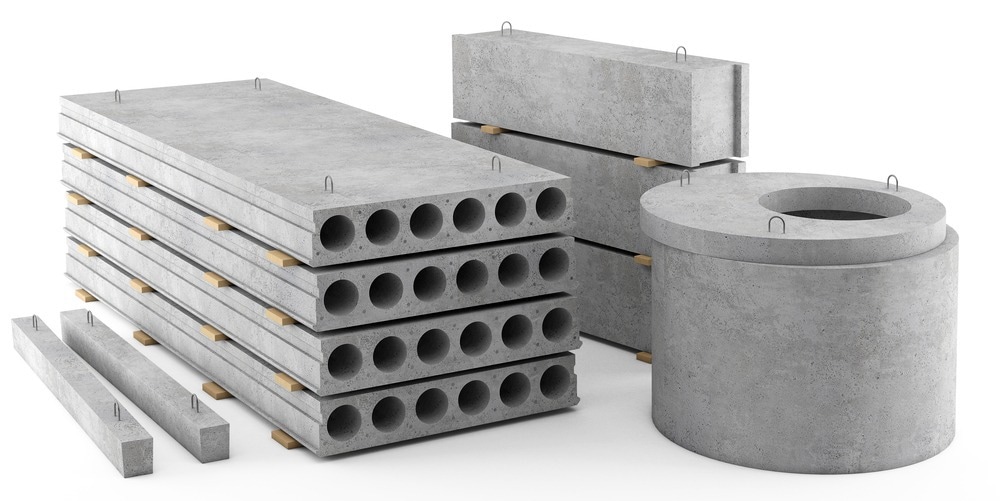Improving the performance of building materials positively impacts the safety and durability of structures. This article explores post-tensioning, a pivotal technique in reinforced concrete construction.

Image Credit: belov1409/Shuuterstock.com
What Is Post-Tensioning?
Reinforced concrete is one of the most commonly employed building materials in the construction industry. To produce reinforced concrete, metal rebar or wire is embedded into the material, thereby enhancing its tensile strength. Also known as ferrocrete, reinforced concrete is a composite material that compensates for the relatively low tensile ductility and strength of concrete.
Post-tensioning further improves the flexibility and structural durability of reinforced concrete, and it has become a key technique in the construction of structures with this common composite building material. As the name suggests, post-tensioning is applied to concrete once it has cured.
The Process of Post-Tensioning
Post-tensioning uses several strategic steps to improve reinforced concrete. The first step involves placing tendons in concrete forms. These tendons are manufactured from high-strength steel.
In the second step, concrete is poured and left to harden. After curing, hydraulic jacks are used to tension the tensons. These are anchored against the concrete’s outer edges. Grouting is subsequently used to fill the ducts, which protects against corrosion.
The Benefits of Post-Tensioning
The primary benefit of using post-tensioning is that it significantly improves the durability and strength of structures built with reinforced concrete. Many high-rise buildings are made from this commonplace building material, and it is crucial that they do not fail. Any failure would present a serious risk to the life of building occupants.
Shrinkage cracking is also reduced by post-tensioning. Post-tensioned reinforced concrete structures require fewer joints—in some cases, none. Any cracks that do form are less likely to spread as they are tightly held together, preventing critical failure and reducing maintenance needs.
Slabs produced using post-tensioning are also thinner compared to their traditionally reinforced counterparts. This improves the efficiency of constructing buildings with post-tensioned reinforced concrete while retaining high strength, structural performance, and durability.
High-rise buildings can benefit from the thinner slabs produced by post-tensioning. One advantage is that the height and weight of structures can be reduced whilst retaining the same number of floors. It also provides cost and time savings.
Aside from safety and efficiency, post-tensioning also has benefits for design freedom. For example, it enables architects and building engineers to design and construct open-plan spaces and unique shapes. Post-tensioning also reduces a building’s carbon footprint as less materials are used and improves thermal efficiency.
However, the adoption of this technique has been hindered due to a lack of awareness and expertise among builders and designers. Post-tensioning remains less widely used as traditionally reinforced concrete, despite its recognized benefits.
Construction Applications
Post-tensioning techniques have been refined and perfected over the past thirty years or so, and today there are several applications for this construction method. Cable corrosion used to be a problem in post-tensioning; however, improved methods and materials have largely eliminated this issue.
Post-tensioned slabs are commonly used as ground slabs. They are especially useful in areas with expansive soils, which tend to move. This is one of the widest uses of post-tensioning in the construction industry.
Concrete water tanks often employ post-tensioned reinforced concrete during their manufacture to minimize the risk of leakage. Post-tensioning is ideal for this as it reduces the possibility of cracking in these structures. This technique is also used in bridge construction, allowing architects to design structures with longer spans.
The possibilities of using post-tensioning in commercial, residential, leisure, and industrial buildings are practically endless. Post-tensioning is therefore fast becoming an indispensable technique in construction.
Post-Tensioned Structures Across the World
The structural advantages of post-tensioning are well recognized in the construction sector, resulting in its application in several iconic structures across the world.
The Sydney Opera House, one of the most iconic buildings in Australia and perhaps the world, utilizes post-tensioning in its distinctive shell-like roof structure. The Shard in London, the tallest building in the UK, uses post-tensioning to provide flexibility and strength.
The Burj Khalifa in Dubai, the tallest building in the world, relies on post-tensioning to provide resistance to wind shear and seismic forces. Without this crucial construction technique, this building would not have been as tall.
Post-tensioning has also been used in other supertall structures such as One World Trade Center in New York. The design versatility of post-tensioning can also be highlighted in the distinctive Marina Bay Sands building in Singapore.
Post-tensioning was vital in the design and construction of the Incheon Bridge in South Korea, enabling its long span while retaining superior strength and durability.
While many buildings utilize this pivotal reinforced concrete method, the examples provided demonstrate that post-tensioning is critical for some of the most complex and demanding structures that define the skylines of major metropolitan areas worldwide.
Conclusion
Post-tensioning reinforced concrete is a vital construction technique that has enabled the design of some of the most iconic structures in the world and is used in many residential, commercial, and industrial buildings. While not as common as traditionally reinforced concrete, this method is making inroads into the sector, with more buildings incorporating this method into their designs each year.
Post-tensioning has many benefits, including enhanced strength, durability, design freedom, and efficient material use, and will undoubtedly continue to shape the built environment for years to come.
More from AZoBuild: Advances in Concrete Reinforcement Techniques
References and Further Reading
Converge. (2023). Post-tensioning in building structures. [Online] Converge. Available at: https://www.converge.io/blog/post-tensioning-in-building-structures.
Popehn, JRB. (2007) Post-tensioned Masonry: The Positive Effects of Stress. [Online] Concrete Construction. Available at: https://www.concreteconstruction.net/how-to/construction/post-tensioned-masonry-the-positive-effects-of-stress_o.
Concrete Network. Advantages & Applications of Post-tensioning. [Online] Concrete Network. Available at: https://www.concretenetwork.com/post-tension/advantages.html.
Disclaimer: The views expressed here are those of the author expressed in their private capacity and do not necessarily represent the views of AZoM.com Limited T/A AZoNetwork the owner and operator of this website. This disclaimer forms part of the Terms and conditions of use of this website.